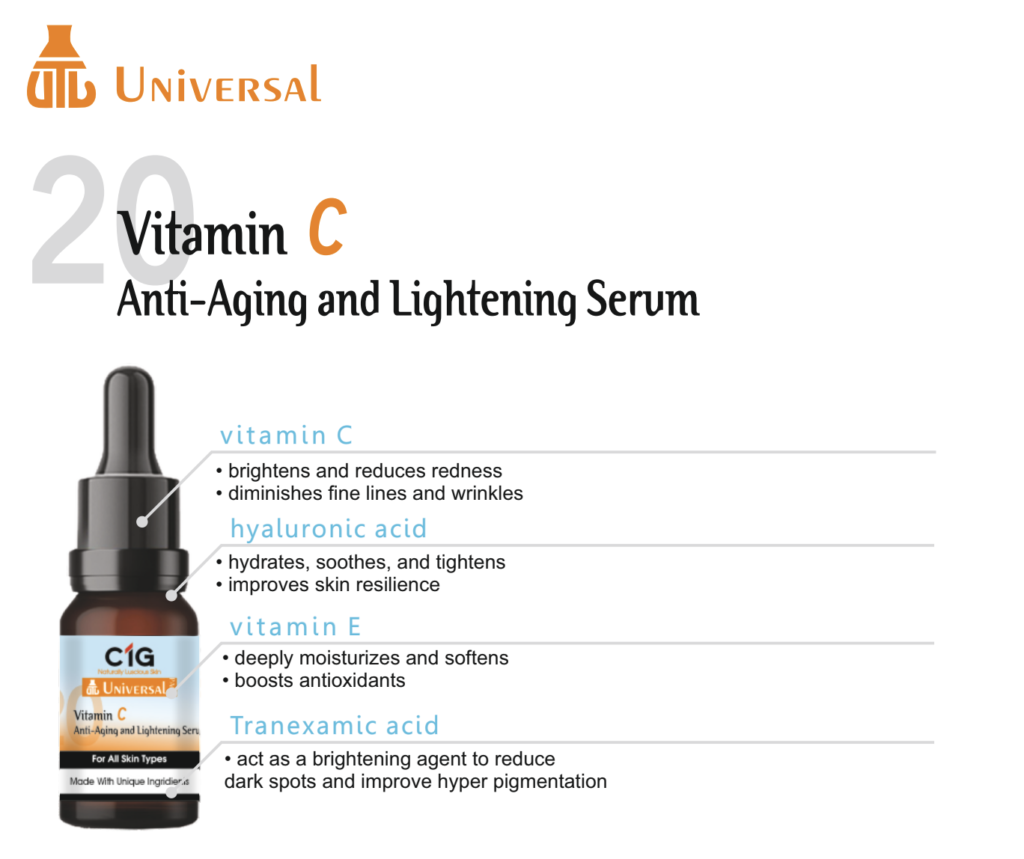vit-c universal C1G
C1G Universal Vitamin C 20% Serum Since the C1G Universal Vitamin C Serum in the form of ascorbic acid is very unstable against any light and air, if used in cosmetic products, after production and over time, the percentage of this substance in the product decreases.
In this Recommended product C1G Universal Vitamin C 20% serum ) , we have tried to keep the percentage of vitamin C constant during the period of customer use and exactly according to our claims on the product packaging. We have used the following simple method:
1. Fill the lotion into the bottle, but keep the ascorbic acid powder in a sealed case in the lid of the bottle.
2. After purchasing the product and starting to use it, the customer presses the button on the tank lid, at this moment the seal case containing the ascorbic acid inside the bottle is opened and the ascorbic acid powder is released inside the lotion.
After about a minute of shaking the bottle by the customer, the powder dissolves completely in the lotion and now the product can be used with the actual percentage of vitamin C. This percentage will be stable in the product for at least 2 months (which of course is about a month for people to use this product).
However, all the contents of the case and the bottle are completely stable for 3 years before mixing. This technology has been used for many years in products around the world, the most famous of which is the 15% vitamin C lotion of ACM France, in which the ascorbic acid case is embedded in the end of the bottle.
Introduction of Vitamin C
Vitamin C is one of the naturally occurring antioxidants in nature.Most plants and animals areable to synthesise Vitamin C in vivo from glucose. Humans and certain other vertebrates lack the enzyme L glucono gamma lactone oxidase required for in vivo synthesis of Vitamin C hence,they must acquire it from natural sources such as citrus fruits, green leafy vegetables,
strawberries,papaya and broccoli. Traditionally, Vitamin C rich foods like lemons were carried by sailors on long journeys to avoid Scurvy, a disease of bleeding gums. In 1937, Dr. Albert Szent Goyrgi was awarded the Nobel Prize for his work in isolating the Vitamin C molecule from red peppers and identifying its role in Scurvy.
L ascorbic acid (LAA) is the chemically active form of Vitamin C. In nature, Vitamin C is found in equal parts as LAA and D ascorbic acid. These are essentially isomeric molecules and are mutually in terchangeable. However, only LAA is biologically active and thus useful in medical practice.
The absorption of Vitamin C in the gut is limited by an active transport mechanism and hence a finite amount of the drug is absorbed despite high oral dosage. Furthermore, bioavailability of Vitamin C in the skin is inadequate when it is administered orally. The use of topical ascorbic acid is therefore favored in the practice of dermatology.

Vitamin C as antioxidant
Vitamin C, the most plentiful antioxidant in human skin, forms a part of the complex group of enzymatic and non-enzymatic antioxidants that co-exist to protect the skin from reactive oxygen species (ROS). As Vitamin C is water soluble, it functions in the aqueous compartments of the cell.
When the skin is exposed to UV light, ROS such as the superoxide ion, peroxide and singlet oxygen are generated. Vitamin C protects the skin from oxidative stress by sequentially donating electrons to neutralize the free radicals. The oxidised forms of Vitamin C are relatively non-reactive. Furthermore, they can be converted back to Vitamin C by the enzyme dehydro ascorbic acid reductase in the presence of glutathione. Exposure to UV light reduces the availability of Vitamin C in the skin.
Vitamin C as a depigmenting agent
When choosing a depigmenting agent, it is important to differentiate between substances that are toxic to the melanocyte and substances that interrupt the key steps of melanogenesis. Vitamin C falls into the latter category of depigmenting agents. Vitamin C interacts with copper ions at the tyrosinase-active site and inhibits action of the enzyme tyrosinase, thereby decreasing the melanin formation. Vitamin C also acts on the perifollicular pigment. However, Vitamin C is an unstable compound. It is therefore often combined with other depigmenting agents such as soy and liquorice for better depigmenting effect